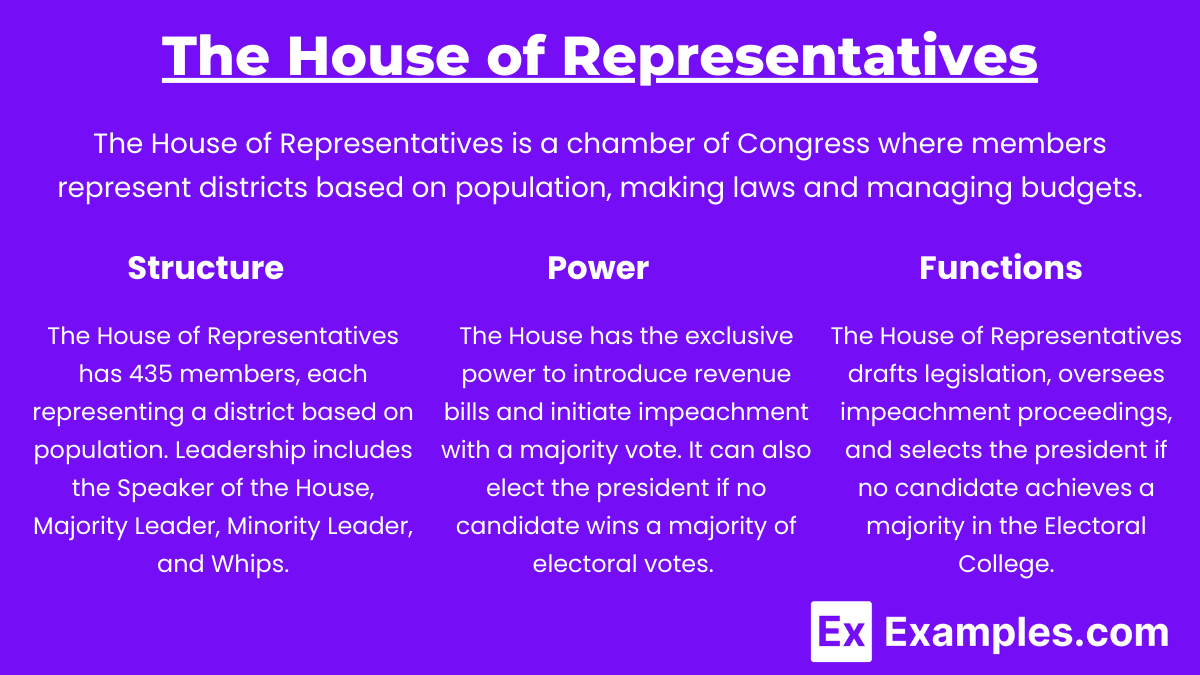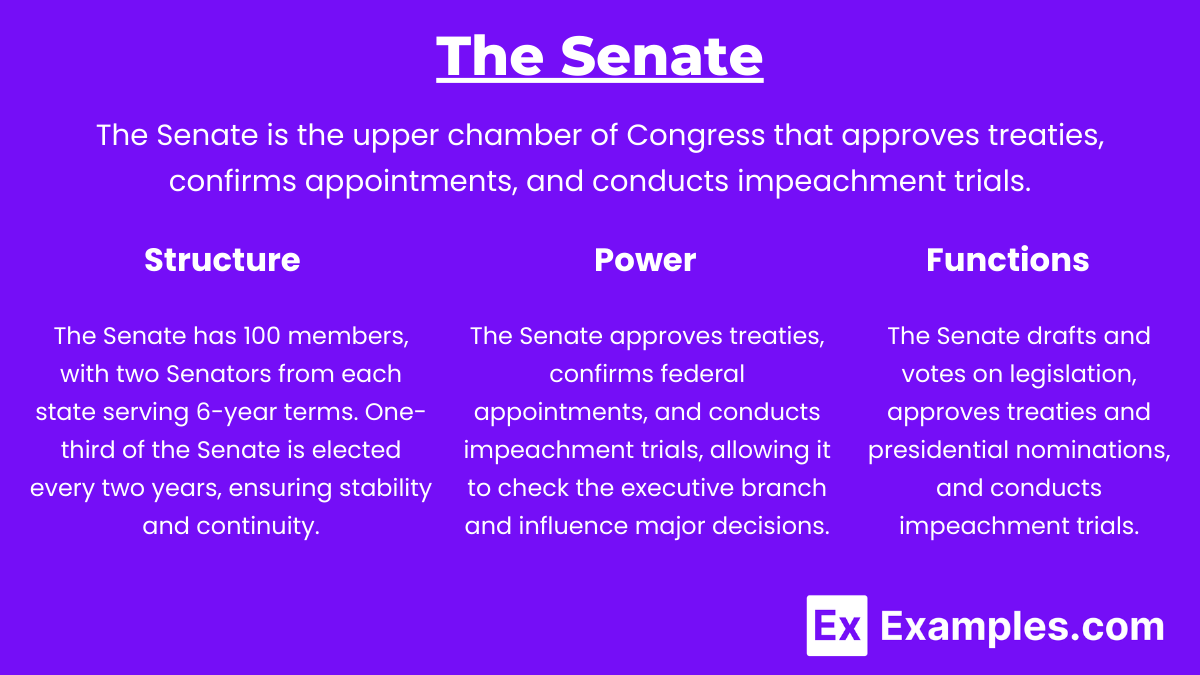The U.S. Congress, composed of the House of Representatives and the Senate, plays a pivotal role in the federal government. Each house has distinct structures, powers, and functions that shape how laws are made and how government operates. The House of Representatives focuses on population-based representation and initiating revenue bills, while the Senate provides equal state representation and handles treaty ratification and confirmations. Understanding these differences is crucial for comprehending the legislative process and the balance of power in American government.
Learning Objectives
In studying “The Structures, Powers, and Functions of Each House of Congress” for the AP United States Government and Politics exam, you should aim to understand several key objectives. First, you need to grasp the bicameral nature of Congress, recognizing how the House of Representatives and the Senate are structured and the rationale behind this two-house system. This includes distinguishing between the House’s representation based on population and the Senate’s equal representation for each state. Second, you should be familiar with the specific powers and functions of each house. This includes the House’s exclusive power to initiate revenue bills and its role in impeaching federal officials, as well as the Senate’s responsibilities in ratifying treaties, confirming presidential appointments, and conducting impeachment trials.
1. The House of Representatives

Structure
- Size: 435 voting members, apportioned based on population. Each state is divided into congressional districts, with each district electing one representative.
- Term: Representatives serve 2-year terms. Elections occur every even-numbered year.
- Leadership:
- Speaker of the House: The presiding officer, elected by the members of the House. The Speaker plays a critical role in legislative agenda-setting and is second in the line of presidential succession.
- Majority Leader: Assists the Speaker and leads the majority party.
- Minority Leader: Leads the opposition party.
- Whips: Party enforcers who ensure party members vote according to party lines.
Powers
- Revenue Bills: The House has the exclusive power to introduce bills related to taxation (often referred to as revenue bills). This originates from the idea that the House, being directly elected by the people, should control the “power of the purse.”
- Impeachment: The House has the sole authority to initiate impeachment proceedings against federal officials, including the president. A simple majority is required to impeach.
- Election of President: If no presidential candidate receives a majority of electoral votes, the House chooses the president from the top three candidates.
Functions
- Legislation: The House plays a central role in drafting and passing laws. Bills can originate in either house, except for revenue bills, which must start in the House of Representatives.
- Representation: Given the smaller districts, representatives are more closely connected to the people they serve. This is why the House is sometimes called “the people’s house.”
- Committee System: The House operates through a vast committee system. Committees review, amend, and refine proposed legislation. Key committees include:
- Ways and Means: Handles tax policy.
- Appropriations: Oversees federal spending.
- Rules: Controls the flow of legislation to the floor and sets the terms for debate.
2. The Senate

Structure
- Size: 100 members, with each state represented by two senators regardless of population size.
- Term: Senators serve 6-year terms, with one-third of the Senate up for election every two years.
- Leadership:
- Vice President: Serves as the President of the Senate but only votes in case of a tie.
- President Pro Tempore: Presides over the Senate in the Vice President’s absence, usually the longest-serving member of the majority party.
- Majority Leader: The most powerful position in the Senate, controlling the legislative agenda.
- Minority Leader: Leads the opposition party.
Powers
- Advice and Consent: The Senate has the authority to confirm presidential appointments, including federal judges, cabinet members, and ambassadors. It also ratifies treaties with a two-thirds majority.
- Impeachment Trials: While the House impeaches federal officials, the Senate conducts the trial. A two-thirds vote in the Senate is required to remove an official from office.
- Election of Vice President: If no vice presidential candidate receives a majority of electoral votes, the Senate elects the vice president.
- Filibuster and Cloture: Unique to the Senate, the filibuster allows senators to extend debate indefinitely, effectively blocking legislation. A cloture vote (requiring 60 votes) can end a filibuster.
Functions
- Legislation: The Senate shares legislative duties with the House, but due to its smaller size and longer terms, it is often seen as more deliberative. Senators have more time to focus on long-term policy and national interests.
- Representation: Senators represent their entire state, which means they focus on broader state and national issues rather than just local concerns.
- Foreign Policy: The Senate plays a significant role in shaping U.S. foreign policy, particularly through its power to ratify treaties and confirm key foreign policy appointments.
- Committee System: Like the House, the Senate relies on committees to manage the workload of legislation. Important Senate committees include:
- Judiciary: Oversees judicial nominations and legal matters.
- Foreign Relations: Shapes foreign policy through treaties and appointments.
- Finance: Handles taxation and revenue-related matters.
Key Differences Between the House and Senate
- Representation: The House is based on population, while the Senate gives equal representation to each state.
- Term Length: Representatives serve 2-year terms, while senators serve 6-year terms.
- Role in Impeachment: The House initiates impeachment, and the Senate conducts the trial.
- Legislative Process: The House tends to work more quickly and is more majoritarian, while the Senate is slower and has rules (like the filibuster) that give more power to the minority.
Shared Powers of Both Houses
- Law-Making: Both houses must pass a bill in identical form for it to become law.
- Oversight: Congress, as a whole, exercises oversight over the executive branch through hearings, investigations, and subpoenas.
- War Powers: Congress has the power to declare war and control military funding.
- Amendment Proposals: Both houses can propose amendments to the Constitution with a two-thirds vote.
Examples
Example 1 : Impeachment Process
- The House of Representatives holds the power to impeach federal officials, including the president, with a simple majority vote. For example, the House impeached President Andrew Johnson in 1868 and President Donald Trump in 2019 and 2021.
- The Senate is responsible for conducting impeachment trials. A two-thirds majority in the Senate is required to remove an official from office. For example, in 1999, the Senate acquitted President Bill Clinton, and in 2021, President Donald Trump was also acquitted.
Example 2 : Revenue Bills
- The House of Representatives has the exclusive authority to introduce bills related to taxation and revenue. This is because the House is viewed as more representative of the people, reflecting their interests in financial matters. For instance, tax reform bills like the Tax Cuts and Jobs Act of 2017 must begin in the House.
- The Senate can amend or reject revenue bills but cannot originate them. It reviews and debates these bills, ensuring that they align with broader national interests.
Example 3 : Advice and Consent Power
- The Senate has the power of “advice and consent,” meaning it must approve presidential appointments to the judiciary, executive branch, and ambassadorships. For example, the Senate confirmed the appointment of Justice Amy Coney Barrett to the U.S. Supreme Court in 2020.
- The House of Representatives does not have this confirmation power, emphasizing the Senate’s unique role in shaping the federal judiciary and executive leadership.
Example 4 : Legislative Committees
- Both the House and Senate use a committee system to handle the workload of legislation. In the House, key committees like the House Ways and Means Committee oversee taxation and budget issues. For example, this committee is involved in drafting major tax legislation.
- The Senate also operates through committees, such as the Senate Judiciary Committee, which is responsible for vetting judicial appointments. For instance, this committee played a key role in confirming federal judges under recent administrations.
Example 5 : Treaty Ratification
- The Senate has the exclusive power to ratify treaties made by the president, with a two-thirds majority required for approval. An example of this is the ratification of the North Atlantic Treaty, which formed NATO in 1949.
- The House of Representatives does not have any direct role in the treaty-making process, showcasing the Senate’s significant influence over foreign policy matters.
Multiple Choice Questions
Question 1
Which of the following powers is exclusively held by the House of Representatives?
A) Ratify treaties
B) Confirm presidential appointments
C) Initiate revenue bills
D) Conduct impeachment trials
Answer: C) Initiate revenue bills
Explanation: The House of Representatives has the exclusive authority to initiate revenue bills, as outlined in the Constitution. This power reflects the principle that the branch of Congress closest to the people (the House) should control the power of taxation. While the Senate can amend or reject these bills, the initiation must begin in the House. The Senate, on the other hand, has the power to ratify treaties (A), confirm presidential appointments (B), and conduct impeachment trials (D), but these are not exclusive to the House.
Question 2
What is required for the Senate to convict an official in an impeachment trial?
A) A simple majority vote
B) A two-thirds majority vote
C) A unanimous vote
D) A majority vote of the Supreme Court
Answer: B) A two-thirds majority vote
Explanation: To convict an official in an impeachment trial, the Senate must achieve a two-thirds majority vote. This high threshold ensures that removal from office is a significant and bipartisan decision. The House of Representatives, which has the power to impeach, only requires a simple majority vote for impeachment. The Supreme Court does not play a role in the impeachment process, making options A, C, and D incorrect.
Question 3
Which of the following roles is primarily associated with the Senate rather than the House of Representatives?
A) Serving as the body that originates all revenue bills
B) Conducting trials for impeached officials
C) Leading the majority party with the title of Speaker
D) Introducing amendments to tax legislation
Answer: B) Conducting trials for impeached officials
Explanation: The Senate is responsible for conducting trials for officials who have been impeached by the House of Representatives. A two-thirds majority is required in the Senate to convict and remove an official from office. The House, on the other hand, is the body that originates all revenue bills (A), while the title of Speaker is associated with the House majority party leadership (C). Both the House and Senate can introduce amendments to tax legislation, so option D is not exclusively associated with the Senate.


